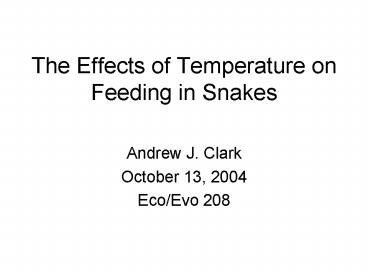The Effects of Temperature on Feeding in Snakes - PowerPoint PPT Presentation
1 / 15
Title:
The Effects of Temperature on Feeding in Snakes
Description:
Thermal dependence of striking and prey capture by gopher snakes. Copeia. 1974: 141-148. ... Sonora Gopher Snake, Pituophis catenifer affinis. SW USA and ... – PowerPoint PPT presentation
Number of Views:32
Avg rating:3.0/5.0
Title: The Effects of Temperature on Feeding in Snakes
1
The Effects of Temperature on Feeding in Snakes
- Andrew J. Clark
- October 13, 2004
- Eco/Evo 208
2
Primary References
- Ayers, D. Y. and Shine, R. 1997. Thermal
influences on foraging ability body size,
posture and cooling rate of an ambush predator,
the python Morelia spilota. Functional Ecology.
11 342-347. - Greenwald, O. E. 1974. Thermal dependence of
striking and prey capture by gopher snakes.
Copeia. 1974 141-148.
3
Ayers and Shine, 1997The Subject
- Diamond Pythons, Morelia spilota
- New South Wales
- a relatively cool environment
- Pythonidae
4
Ayers and Shine, 1997 Hypothesis
- SA/vol ratio is decreased by large size tight
coiling - Retards cooling rate
- Increases time needed for detecting and capturing
prey
5
Ayers and Shine, 1997Measurements
- Cooling Rates
- 3 body sizes
- hatchlings, juveniles, adults
- 2 postures
- outstretched coiled
- Tongue-Flick Cycle Rates
- 3 body sizes
- hatchlings, juveniles, adults
- 3 temperature settings
- 10ºC, 20ºC, 30ºC
6
Ayers and Shine, 1997Results
- Cooling Rates
- equilibration times thermal temperature
constants were significantly different among size
groups - Thermal T Constant (t) Q x R
7
Ayers Shine, 1997Results
- Equilibration Times
- Thermal Temperature Constants
8
Ayers and Shine, 1997Results
- Tongue-Flick Cycle Rates
- increased rapidly at higher temperatures
9
Greenwald, 1974The Subject
- Sonora Gopher Snake, Pituophis catenifer affinis
- SW USA and Mexico
- Colubridae
10
Greenwald, 1974
- Measured strike speed and success of strike
- At different body temperatures
- 18ºC, 22ºC, 27ºC, 33ºC
11
Greenwald, 1974Results
- Mean velocity
- Maximum velocity
- Prey capture success
Increased with increasing body temperatures in
the range tested
12
Greenwald, 1974Results Mean Velocity
13
Greenwald, 1974Results Maximum Velocity
14
Greenwald, 1974Results Prey Capture Success
15
Questions Comments































